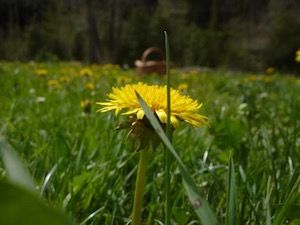Common Dandelion
I- Nomenclature
Latin name: Taraxacum officinale Weber
Family : Asteraceae
Common names: Common dandelion, dandelion
Etymology
"Taraxacum" from the Greek "taraxis": eye disorder (latex from dandelions was in fact believed to calm eye irritations). From the Latin "officinale": the plant is one of the simple of the dispensaries. In French, the word dandelion finds its origin in the popular expression "pisser dans le lit": the dandelion is a diuretic plant.
II- Legends and traditions
Apollo is, in Greek mythology, the most beautiful of the gods. Son of Zeus, the supreme god, he is the protector of music and poetry, sources of eternal pleasure. He knows the future and he is the master of light. God-Sun, when autumn arrives, he leaves Greece in his chariot drawn by white horses and goes north where the sky is always pure, not to return until the following spring. Legend has it that it is from the light dust raised by the wheels of his chariot that the dandelion with light crested egrets dispersed by the wind is born and whose flower closes at sunset.
III- Botanical description
Description: Perennial herbaceous plant of 10 to 50cm with simple floral stems releasing a white latex when broken. The leaves are indented, dentate, lobed, long and polymorphic, distributed in a rosette on the crown of the plant. The flowers are golden yellow, hermaphrodite and ligulate united in large solitary heads at the end of the stems. Fruits: cypsela - achenes with a tassel of hairs forming a ball when ripe.
Habitat:
The dandelion grows on the edge of woods, in ditches, pastures and meadows. A ruderal plant, the dandelion abounds in wasteland, rubble and along the paths near the places of human habitation.
Harvest:
Flower buds, flowers and leaves are harvested at the start of flowering. The root in early spring or in autumn.
Pars used : Floral buds, flowers, leaves and roots.
IV- Active ingredients
|
Leave |
Root |
|
• rich in vitamins A: 700 times more than pear, 70 times more than oranges and twice as much as spinach • vitamins B1, B2, C and E • mineral salts: Ca, Mg, P, K, Na, CI, S, Fe, Mn, Si, in large proportions • bitter glycosides, carotenoids, terpenoids and choline |
• bitter glycosides • tannins • tri terpenes • sterols • volatile oil • choline, asparagine • inulin latex containing a bitter principle (lactupricin) |
V- Therapeutic uses
Properties
|
Leaves |
Root |
|
• digestive • diuretic • hepatic • tonic |
• anti-rheumatic • choleretic • diuretic • mild laxative liver tonic |
Indications
Leaves
Excellent diuretic, the leaves are rich in potassium which is usually lost with frequent urination used to combat fluid retention, particularly in cases of vascular problems, as well as for other urinary disorders the leaves are also an effective tonic for the liver and digestive system
Racine
Rétention d'urine, rétention d'eau, insuffisance hépatique, jaunisse, maladies de la peau
constipation
conditions de toxicité chronique comme l’inflammation des articulations, l’eczéma et l’acné
Dosage
Decoction: spring cleanser, gallstones: in decoction 100 gr of dandelion roots for one liter of water. Boil 5 min and drink 3 cups / day.
Infusion: same indication, 25gr of dandelion leaves in a liter of water. Let cool and pass. A small glass in the morning on an empty stomach.
Juice: in case of kidney stones: squeeze fresh dandelions in a cloth to release the juice White. You can sweeten it a little because the taste is bitter; 20 to 30g / day. The fresh juice is also used on ulcers and inflammation of the eyelids and freckles.
Roasting: the root is often roasted and added to that of chicory. Tincture: often added to remedies for vascular problems to ensure adequate intake of potassium.
VI- Precaution of use
Contraindication
Bile duct obstructions Latex allergy (very rare)
Interaction The diuretic effect of the leaves could be added to those of other diuretic plants. The chanvrine eupatory is found throughout France, Europe, Asia Minor and northern Africa. It grows readily in humid areas, on the edges of ditches, in marshes, up to 1700 meters of altitude.


